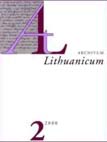Ar Jono Bretkūno Biblija buvo jo Postilės redagavimo šaltinis?
Was Jonas Bretkunas’ Bible the Source of Editing his Postilla?
Author(s): Ona AleknavičienėSubject(s): Language and Literature Studies
Published by: Lietuvių Kalbos Institutas
Keywords: Bretkunas; Vilentas; translation; Postilla; Bible; textual criticism; Pericopes; addition; New Testament; Gospels and Epistles; editing; textological analysis; Liudvikas Reza; sermons; transcript; manuscript; correction; linguistic units; synonymy
Summary/Abstract: The paper analyzes the relation between Jonas Bretkunas’ Postilla (1591, BP) and his translation of the New Testament (translation completed in 1580, BNT). Analysis of the relation between the pericopes of BP and BNT has pursued two main goals: 1) to make certain whether the pericopes of BP are closer to the pericopes of Baltramiejus Vilentas’ Euangelias bei Epistolas (Gospels and Epistles, 1579, EE) than BNT; and 2) to answer the question whether BNT could have been the source of editing the pericopes of BP. The textological analysis conducted has partially confirmed the idea put forward by Liudvikas Reza in 1816 that Bretkunas compiled the collection of sermons following Vilentas’ EE: 67 pericopes out of 69 were taken from EE, but not from BNT. On the other hand, these excerpts from the Bible are not an ordinary reprint of Vilentas’ texts but rather a transcript with many corrections. No convincing evidence has been found that Bretkunas, when editing the excerpts taken from Vilentas’ EE, based himself on his own BNT manuscript. It has already been established earlier that the additional pericope Mt 3.13-17 inserted in BP and the sections added from the Bible (omitted in Vilentas’ EE) were not copied from BNT but were translated anew. The statement that the correction of the EE texts included in BP did not follow BNT is based on the following facts: 1. If in correcting Vilentas’ text the linguistic units changed in BP coincide with BNT they most often also match one or even several of the originals. When copying the EE text, words were added in BP, which are found only in BNT and are mostly dependent and do not carry much probative value. Words omitted in BP, which are missing only in BNT, are of little significance either. 2. In some places BP differs from EE and coincides with BNT due to the fact that Bretkunas, guided by a good feel for the Lithuanian language, departs slightly from the originals. These coincidences are determined by the Lithuanian language system. 3. The majority of other BP and BNT coincidences are to be attributed to the potential of Lithuanian synonymy: BP and BNT coincide, but they differ from EE usually in lexical and syntactical synonyms having a very close meaning. 4. Some of the linguistic units, which coincide in BP and BNT, but differ from EE, are terms or constructions already established in Bretkunas’ language: attempts are made to retain them both in BP and BNT. 5. When preparing BP, Bretkunas did not make use of his BNT because his translation of the Bible had not yet been approved at that time.
Journal: Archivum Lithuanicum
- Issue Year: 2000
- Issue No: 02
- Page Range: 11-50
- Page Count: 40
- Language: Lithuanian

